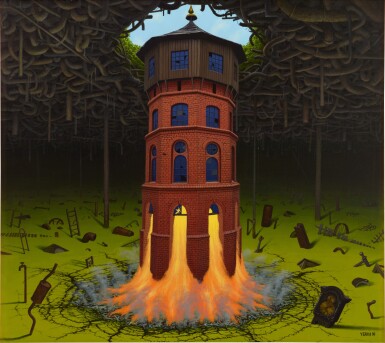
Property from an American Private Collection
Jacek Yerka
Underwater Tower
Lot Closed
November 29, 03:17 PM GMT
Estimate
20,000 - 30,000 EUR
Lot Details
Description
Property from an American Private Collection
Jacek Yerka
Polish
b. 1952
Underwater Tower
signed and dated YERKA 96 lower right and signed, titled, inscribed and dated JACEK YERKA / "UNDERWATER-TOWER" / AKRYL 1996 on the stretcher
acrylic on canvas
Unframed: 65 by 72.5cm., 25½ by 28¾in.
Framed: 72.5 by 81cm., 28½ by 32in.
Morpheus Fine Art, Las Vegas
Purchased from the above by the present owner in 2007
The present work, by Jacek Yerka continues in the watery vein of An Oceanic Bathroom (see lot 16), this time eschewing the marine in favour of the swamp. The painting, in brilliant acrylics, depicts a polygonal red-brick tower being propelled (as though it were a space rocket) by enormous flames from a stagnant, algae covered pond. As it takes off, the tower travels through a circular opening into a blue sky above.
As with the other lot in this sale by Yerka, the artist has painstakingly drawn and coloured every minute detail of the work, from the individual bricks of the tower down to the beautifully observed breaking apart of the algae on the water’s surface. The homogenous expanse of green in the painting’s lower register offsets the forensic detail with which a seemingly random collection of discarded items are represented. A long case clock, a bedframe and a car’s exhaust pipe are amongst the objects that protrude from the water.
If Yerka was emulating the techniques of the old masters, then his subject is indebted to the more recent movement of Surrealism. Underwater Tower certainly shares some of the characteristics of Max Ernst’s 1940s output, especially when we consider the elaborate, organic constructions found in Ernst paintings such as Europe After the Rain II (1941). In Yerka’s painting, we see the artist emulating Ernst in the complex weave of the canopy that covers the swamp below. In much the same way as An Oceanic Bathroom, Yerka complicates the boundary between the natural and the man-made; we are invited to try to ascertain whether the canopy is arboreal or mechanical.
This work would seem to subvert trope of external threat evident in An Oceanic Bathroom. In the present picture, it is the internal space that is made ominous in its signifying of darkness and decay, whereas the opening to the outside world promises a release from this.
You May Also Like










